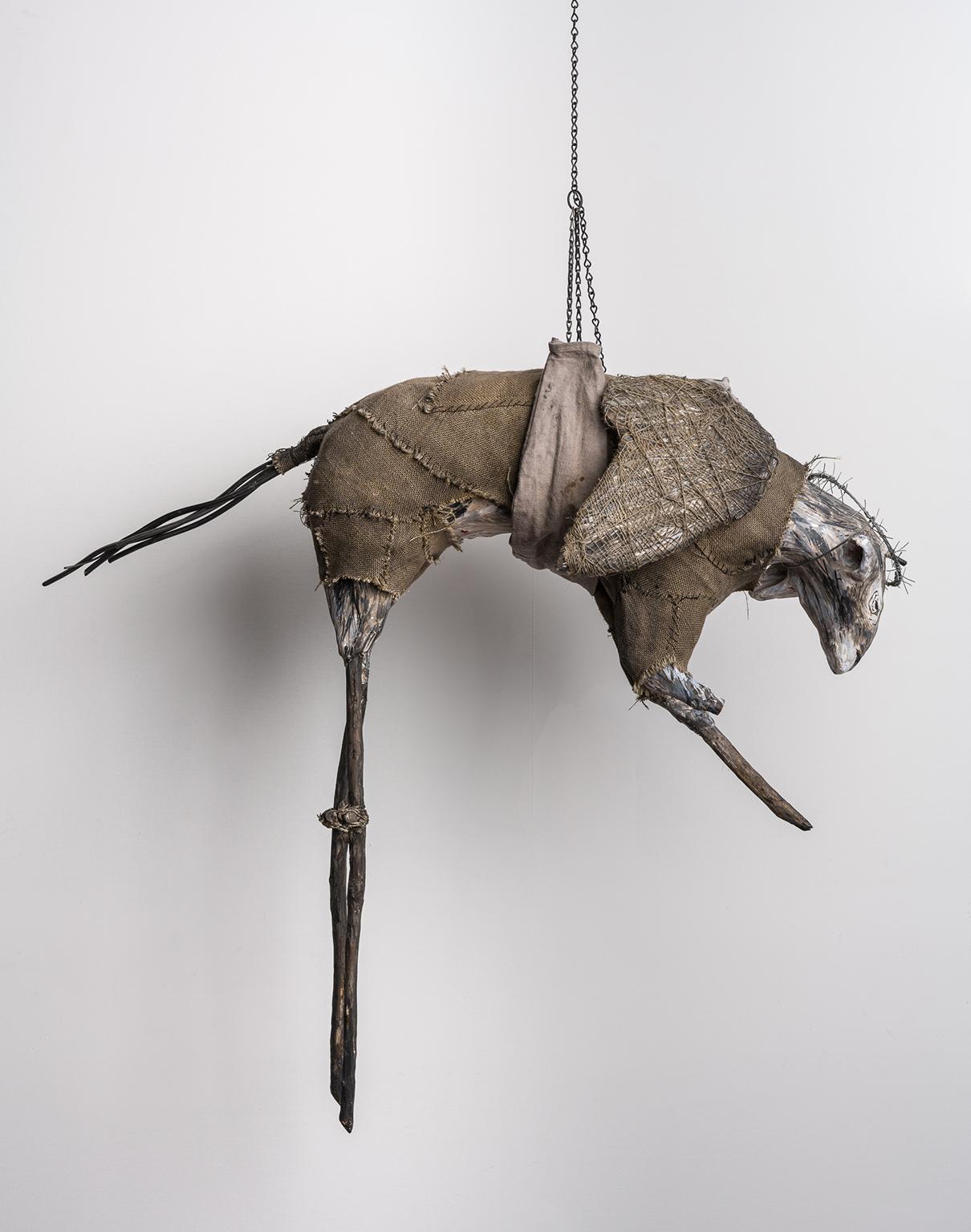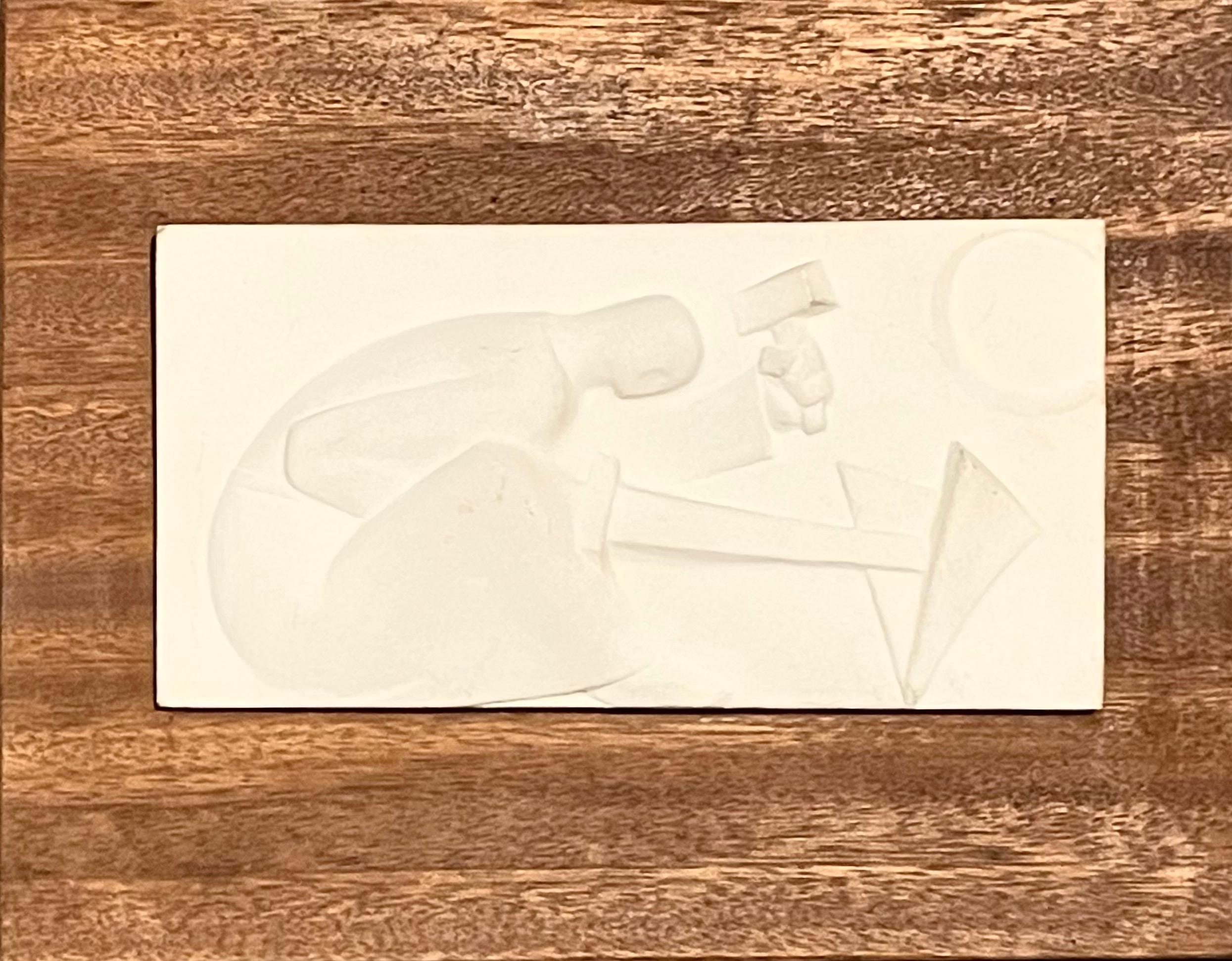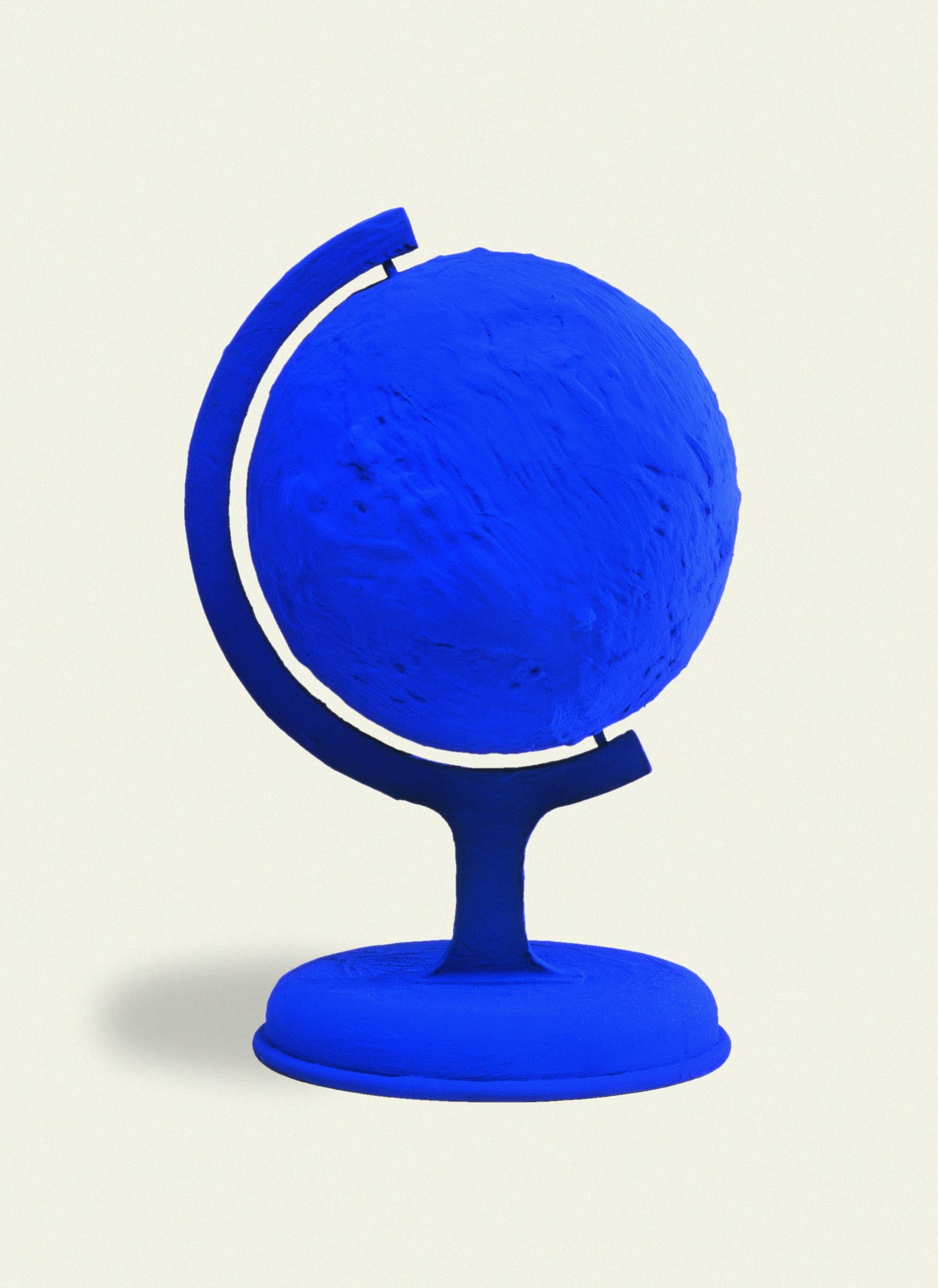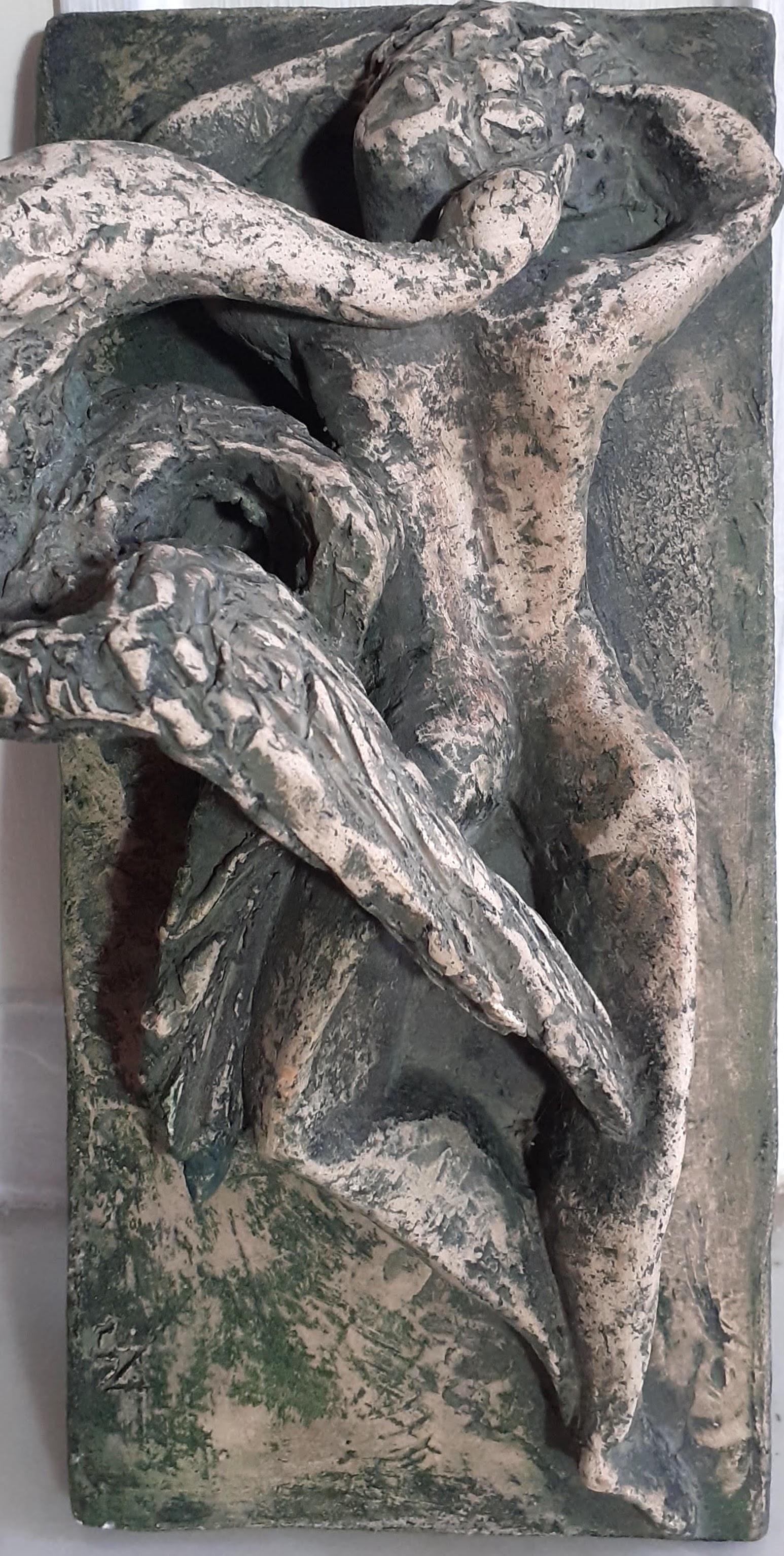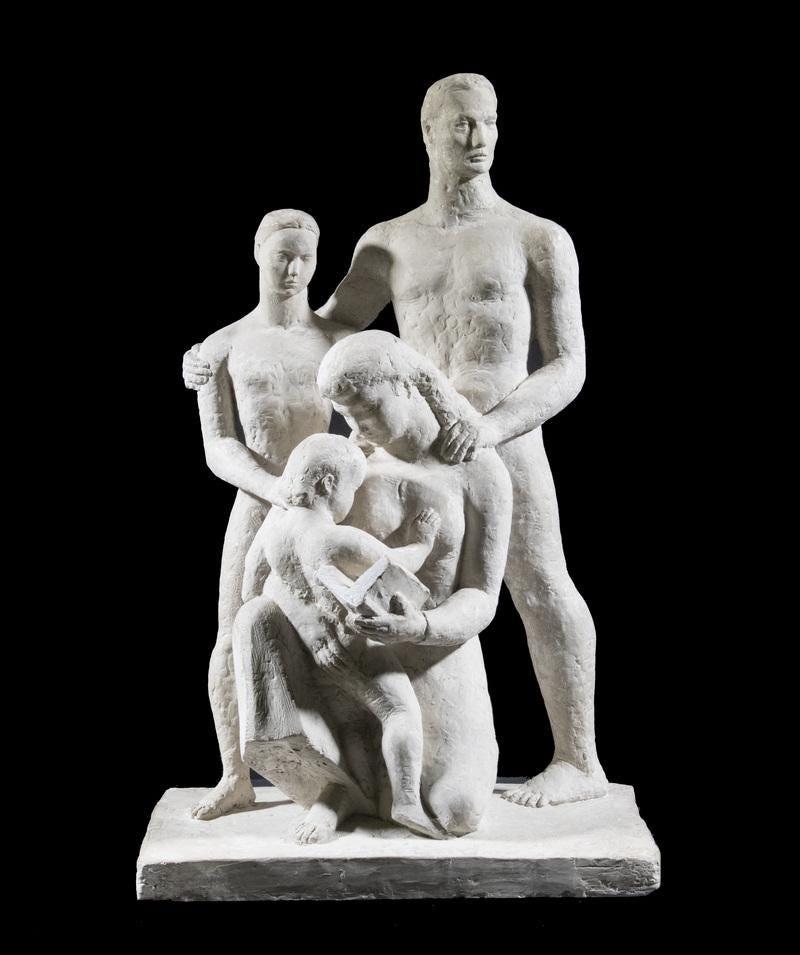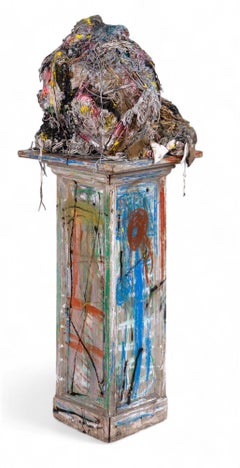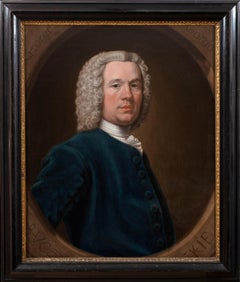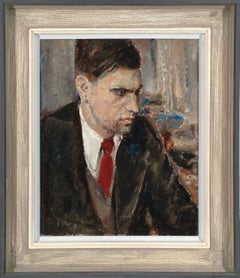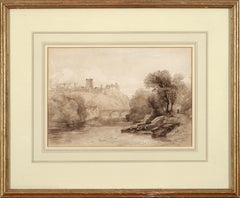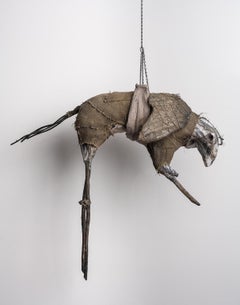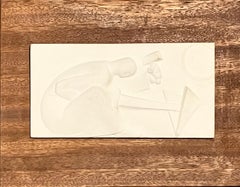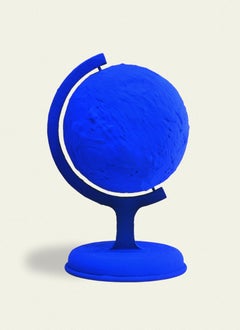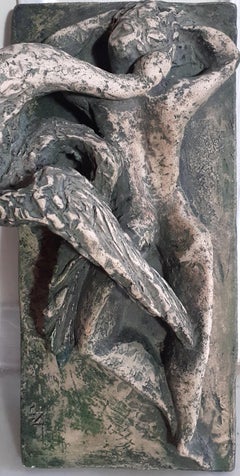Items Similar to Head of Niobe, from the Niobe group
Want more images or videos?
Request additional images or videos from the seller
1 of 7
Gebrüder MicheliHead of Niobe, from the Niobe group
About the Item
Gebrüder Micheli (Micheli Brothers), Berlin, 19th century
Head of Niobe, from the Niobe group
Plaster cast
Inscribed verso, ‘Gebr Micheli Berlin’
80 x 55 x 38 cm.
Provenance:
Gebrüder Micheli, Berlin;
Technical school, history of art department, Netherlands;
Peter Hone, London;
Lay’s Auctioneers, Peter Hone: The London Collection, 12 October 2023, lot 64;
Private Collection, United Kingdom.
This considerable plaster bust is modelled after the 2nd century AD marble, depicting the mortal Niobe and her youngest daughter cowering from death. Now in the Uffizi (1914 no. 294), the sculpture was discovered in a vineyard near Rome in 1583, and belongs to a series of thirteen which depict the murder of the Niobids. After Niobe boasted to Leto of her fourteen children, Leto dispatched her own children Apollo and Artemis to punish Niobe’s hubris. In this final iteration of the group, Niobe shields her youngest daughter within her robes, her face contorted with a pained maternal stoicism. Following the slaughter of her seven sons and seven daughters, Niobe was turned to stone, though her tears became an everlasting fountain. Typically Hellenistic in their pathos, the sculptures were themselves copies of originals believed to have been sculpted by Skopas or Praxiteles. Casts were made of the Uffizi version as well as copies, which include those at the Museum of Classical Archaeology, Cambridge, and the Royal Academy (RA 03/1516). The bust is affixed to a waisted socle typical of the Gebrüder Micheli, similar to their bust of Hermes of Olympia in the UCL Art Museum (LDUCS-10002).
The present example was cast from a derivate sculpture in the 19th century by the German Gebrüder brothers, whose successors now comprise the plaster cast workshop of the State Museums of Prussian Culture. The brothers were renowned dealers in sculpture who produced casts of sculpture they modelled, and also produced copies of bronze works that were to be melted down. The cast was afterwards in an academic collection in the art history department of a Netherlands technical college, according to a label verso which reads: ‘Tehnische Hoogeschool Afdeeling Algemeene Wetenschappen Handteekenen En Kunstgeschiedenis’. The bust was formerly in the long-standing Peter Hone collection, the collector and plaster caster whose famed Notting Hill flat comprised a trove of fragments of marble and plaster both collected and created by Hone. His sale at Christie’s in 2016 was an outstanding testament to the quality of his collection.
The work was likely made using a plaster ‘piece mould’ method, although gelatine moulds were occasionally used in the 19th century. A ‘piece mould’ was made by gradually applying plaster to an object over time, the layers separated by a thin shellac lacquer to prevent sticking. The hardened sections of plaster were then removed in section pieces and reassembled within a fitted metal armature, and the inner layer coated with shellac. The cast is created by pouring plaster of Paris into the tightly assembled piece mould, which is turned to release air bubbles. After the piece mould is removed and the plaster left to dry, fine lines (or ‘flash lines’) of the section joins are carefully removed by gentle sanding.
- Creator:Gebrüder Micheli (German)
- Dimensions:Height: 31.5 in (80 cm)Width: 21.66 in (55 cm)Depth: 14.97 in (38 cm)
- Medium:
- Period:
- Condition:The work is in fair and stable condition. Significant losses to the lower socle base occurring prior to acquisition. Marks to the plaster surface throughout commensurate with age.
- Gallery Location:Maidenhead, GB
- Reference Number:Seller: Gebrüder Micheli1stDibs: LU2820215588072
About the Seller
New to 1stDibs
Joined in the past six months.
No Reviews Yet
Vetted Professional Seller
Every seller passes strict standards for authenticity and reliability
Established in 2024
1stDibs seller since 2024
- ShippingRetrieving quote...Shipping from: Maidenhead, United Kingdom
- Return Policy
Authenticity Guarantee
In the unlikely event there’s an issue with an item’s authenticity, contact us within 1 year for a full refund. DetailsMoney-Back Guarantee
If your item is not as described, is damaged in transit, or does not arrive, contact us within 7 days for a full refund. Details24-Hour Cancellation
You have a 24-hour grace period in which to reconsider your purchase, with no questions asked.Vetted Professional Sellers
Our world-class sellers must adhere to strict standards for service and quality, maintaining the integrity of our listings.Price-Match Guarantee
If you find that a seller listed the same item for a lower price elsewhere, we’ll match it.Trusted Global Delivery
Our best-in-class carrier network provides specialized shipping options worldwide, including custom delivery.More From This Seller
View AllCleanse, Fold and Manipulate
Located in Maidenhead, GB
William J. O’Brien (b. 1975)
Cleanse, Fold and Manipulate (2007)
Oil paint, aerosol paint, wood, string, carpet, wax, and other mixed media
136 x 53 x 48 cm.
Provenance:
William J...
Category
Early 2000s Contemporary Abstract Sculptures
Materials
Mixed Media
Portrait of George Gordon, 7th Laird of Buckie (1707-1756)
By John Alexander
Located in Maidenhead, GB
John Alexander (Scottish, 1686-1766)
Portrait of George Gordon, 7th Laird of Buckie (Scottish, 1707-1756), c. 1743
Oil on canvas
In a carved ebonised frame, with gilded inner slight...
Category
1740s Old Masters Portrait Paintings
Materials
Oil
Young Man in a Red Tie
Located in Maidenhead, GB
Dame Ethel Walker DBE ARA (1861-1951)
Young Man in a Red Tie
Oil on canvas
51 x 40.6 cm.; (within frame) 70 x 59.7 cm.
Provenance:
The Lefevre Gallery, London, stock number X890;
Christie’s, London, Modern British Pictures, Watercolours, Drawings and Sculpture, 12 September 1996, lot 58;
Bonhams, London, Modern British and Irish Art, 23 November 2022, lot 177;
Private Collection, United Kingdom.
This focussed composition is dominated by a handsome young man in profile, frowning with a concentrated glare. His slender cheeks meet a jaw brushed with a masculine grey, complimented by the blue of a flower or pocket square, and the shadow of a loose strand of oiled hair that rests across his forehead. The stylistic sophistication shows Walker at her best, ambitiously combining measured figuration with expressive abstraction, as delicious dashes of pigment appear still wet, and dissonant swipes energetically mark the surface of the canvas. With an elegance that borders on the effete, the sitter’s urbane style includes a spearpoint collar, framed by the wide lapels of his suit jacket. Most significantly, the young man’s dandyish fashion is augmented by the conspicuous titular red tie which he wears – an established expression of queerness in the 20th century. Painted by the lesbian artist Dame Ethel Walker, it is likely that the portrait is that of a gay man belonging to London’s queer artistic circles. Indeed, Walker’s male sitters (who constitute but a fraction of her output) are typically conceived as modish, and often wear striking colourful ties. Walker was one of the earliest lesbian artists to overtly explore her sexuality in her works, and an aesthetic fascination with the female form culminated with her glorious large-scale ‘decorations’, exemplified by Decoration: The Excursion of Nausicaa (Tate, N03885).
Red neckties had been established in the 20th century as a coded (though appropriately colourful) expression of queerness, not dissimilar to the green carnation of the Wildean aesthetes. The gay writer and musician Mikhail Kuzmin was painted in 1909 in a stark red tie. Two decades later, the Anglo-French physician Havelock Ellis described the red necktie as an emblem amongst queer New Yorkers: ‘[…] there has been a fashion for a red tie to be adopted by inverts [homosexuals] as their badge’ (Ellis, p. 299). The motif permeated fiction, and in Thomas Mann’s 1912 novel Death In Venice, the protagonist Gustav von Aschenbach begins to wear a red necktie after he develops an infatuation with a beautiful young boy staying at his hotel. William Faulkner’s 1929 novel The Sound and the Fury includes an unnamed male character identified throughout by his distinctive red necktie, which is the subject of veiled insinuations against his masculinity.
Walker must surely have been familiar with this symbolic importance when she executed the present portrait. Her few portraits of male sitters include colourful neckties almost exclusively, and include numerous examples of red neckties. Indeed, the artist herself preferred to wear a red tie, a declaration which so impressed itself on Virginia Woolf that she noted it in a diary entry after tea with Walker (Bell, p. 282). Walker, who painted Woolf’s sister Vanessa Bell, had once offered to paint Woolf in the nude, as Lilith. Around the same time, Augustus John painted the gay peer Evan Morgan, 2nd Viscount Tredegar, in a loose red necktie or neck scarf. The portrait passed through the Lefevre Gallery, which also represented Walker, and which inventoried the present work. While the sartorial choice may have been incidental, a colourful accessory chosen to enliven the portrait, its prominent inclusion would suggest a personal significance to Walker, the recognition of a shared experience between artist and subject.
Dame Ethel Walker was hailed as a leading female artist of her generation, and as late as 2010 was one of only four women artists to have been honoured as a Dame Commander of the Order of the British Empire. Walker was born in Edinburgh in 1861 to the botanist Arthur Abney Walker, a descendent of the Walker family of iron industrialists, whose estates included Clifton House (Rotherham) and Blythe Hall (Nottinghamshire). She attended school in London after the family moved to Wimbledon, and in 1880 met the fellow artist Clara Christian, with whom she would form an important personal and professional bond. The women’s relationship was later allegorised by the writer George Moore as that of Stella (Christian) and Florence (Walker) in his fictionalised three-volume memoir Hail and Farewell. Walker went on to Putney School of Art and Westminster School of Art, and studied under Frederick Brown, who became a lifelong mentor. Around 1893 Walker took further study at the Slade School of Art, partly under Walter Sickert, and returned in 1912, 1916, and 1921. Although Walker enjoyed painting floral still lifes and seascapes, her best work was portraiture. She worked from her studio at 38 Cheyne Walk for most of her career, and enjoyed a prominent role in London’s artistic milieu. Her sitters included the artists Lucien Pissarro, Orovida Camille Pissarro, Vanessa Bell, and Barbara Hepworth; she painted Nancy Astor, the Countess of Strathcona, the editor Joan Werner Laurie, and author Leo Walmsley. The actors Flora Robson and Elsa Lanchester sat for Walker, as did the young Christopher Robin Milne. Walker herself was photographed by the bisexual photographer and painter Humphrey Spender...
Category
Early 20th Century Post-Impressionist Portrait Paintings
Materials
Oil
Sketch of Richmond Castle, North Yorkshire
Located in Maidenhead, GB
David Cox Junior (1809-1885) (attr.)
A sketch of Richmond Castle, North Yorkshire
Graphite and wash on paper
17.6 x 25.8 cm.; (within frame) 35.6 x 43.4 cm.
Provenance:
Private Co...
Category
Mid-19th Century Victorian Landscape Drawings and Watercolors
Materials
Watercolor, Graphite
1879 Christmas card envelope depicting Alice, the White King and his messenger
Located in Maidenhead, GB
British, December 1879
After John Tenniel (1820-1914)
A philatelic cover depicting Alice, the White King and his messenger, with a ham sandwich
An adaption of the illustration to Le...
Category
1870s Victorian Animal Drawings and Watercolors
Materials
Ink
Watercolour study of a resting infant, possibly the artist's daughter
By William Henry Hunt
Located in Maidenhead, GB
William Henry Hunt OWS (1790-1864) (attrib.)
Study of a resting infant
Watercolour and graphite heightened with zinc oxide on paper
13.9 x 18.5 cm.; (within frame) 31.1 x 25.6 cm.
P...
Category
Mid-19th Century Victorian Portrait Drawings and Watercolors
Materials
Watercolor
You May Also Like
Suspended Sculpture of Goat: 'Jersey Devil V'
By Elizabeth Jordan
Located in New York, NY
Elizabeth Jordan is an artist working primarily in sculpture and whose work uses multiple materials to produce unique, organic forms. In addition to a solo and group shows at Ivy Brown Gallery, she has exhibited at The American Academy of Arts and Letters, the Nassau County Museum of Art, The Cornell Art Museum in Delray Beach, Florida and the New York Artists Equity Gallery. In 2023, she received a 2023 Fellowship from the New Jersey State Council on the Arts in sculpture, and in 2022 was awarded the Alex J...
Category
2010s Contemporary Figurative Sculptures
Materials
Wire
Plaster Sculpture Relief Art Deco Plaque WPA Artist Peace Swords to Ploughshares
By George Aarons
Located in Surfside, FL
Size includes wood mounting.
George Aarons (born Gregory Podubisky, in St. Petersburg, Russia, 1896 - died in Gloucester, Massachusetts 1980) was a distinguished sculptor who lived and taught in Gloucester, Massachusetts, for many years until his death in 1980. He had, many students in the area and he designed Gloucester's 350th Anniversary Commemorative Medal.
Aarons moved from Russia to the United States when he was ten. His father was a merchant. He began taking drawing classes during evenings at Dearborn Public School in Boston as a teenager and went on to study at the Boston Museum of Fine Arts in 1916. Aarons later moved to New York City to study with Jo Davidson, and other Paris-trained masters at the Beaux-Arts Institute. He eventually returned to the Boston area and established studios in Brookline and Gloucester, Massachusetts. During his lifetime, he was recognized internationally and won several prestigious awards. Aarons had studios in Brookline, Massachusetts and Gloucester, Massachusetts where he produced large bronze and marble figures and wood carvings. He produced several projects for the Works Progress Administration including a group of three figures for the Public Garden (Boston), a longshoreman, fisherman and foundry worker, as well as a large relief (1938) for the South Boston Housing Project and façade of the Baltimore Hebrew Congregational Building (1956).
His works are at the Museum of Art in Ein Harod, Israel; Fitchburg Art Museum in Massachusetts, Musée de St. Denis in France; Hilles Library at Radcliffe College in Cambridge, Massachusetts; and Hillel House at Boston University in Massachusetts.
He did reliefs for Siefer Hall at Brandeis University in Waltham, Massachusetts (1950); Edward Filene (the founder of Filene's Department Store and a philanthropist) on the Boston Common; Fireman's Memorial in Beverly, Massachusetts; a memorial to Mitchell Frieman in Boston; the U.S. Post Office in Ripley, Mississippi; and at the Cincinnati Telephone Building; the Combined Jewish Philanthropies building in Boston (1965); and a commemorative medal for the 350th Anniversary of the City of Gloucester, Massachusetts (1972).
Characteristic of his era, George Aarons was among the foreign-born American sculptors of the early 20th century who started their careers as academicians and evolved into modernists and increasingly abstract artists.
Over thirty pieces spanning the length of this sculptor's career were featured in this exhibition, including work in various medium bronze, wood and original plasters. Like his contemporaries, Aarons experimented with direct carving in wood, and he was one of the few academically trained sculptors who consistently cut his own works in marble. His early work was classically inspired figurative work, along with sensitive portraits. Some of his most powerful sculpture comes from his middle period, when he worked through his emotional pain following the global realization of the Jewish Holocaust. He depicted humanity deep anxiety over this tragedy with figures that are at once symbolically charged and movingly beautiful. Aarons late work consists of radically simplified forms that continue to reference the human form and often are carved directly in wood and stone.
Aarons summered and taught classes on Cape Ann for many years before moving to Gloucester full-time with his wife about 1950. While Aarons is best known locally for his domestic-scale works, he also executed numerous monumental, public commissions that can be found throughout the United States in cities such as Washington, D.C.; Baltimore, Maryland; and Cincinnati, Ohio; as well as in France and Israel.
As noted in a Gloucester Daily Times Article, Aarons wanted his sculptures to honor the struggles and nobility of people and rail against the evil done against them. And that was why, even as his work grew more and more abstract, stylized and simplified, he never left behind the form of the human figure that had been his focus from his earliest works.
Aarons told the Gloucester Daily Times in September 1954 that he found it hard to remember at just what age he started studying art, but he recalled that the nude model had to partially dress when he was in class because he was so young. He initially studied painting and drawing at the museum school, but he once said he became fascinated by sculpture when he met an established sculptor at the Copley Society in Boston who invited Aarons to his studio and offered him some clay to "play around" with.
After he graduated, he apprenticed under sculptors Richard Brooks, Robert Baker and Solon Borglum. He worked as a carpenter, shipbuilder, dishwasher and chimney sweep. He fashioned architectural decorations, including figures for fountains and now and then a few commissioned portraits. He returned to Boston by the early 1920s and began to exhibit his own works and get commissions for portraits, fountains and reliefs.
His sculptures from this time are dreamy and romantic in the realistic, academic style of the time. A painted portrait of the young Aarons that is included in the North Shore Arts Association exhibit shows a determined fellow with dark brown hair, a suit and bow tie. However, in 1922, this determined young artist was living with his parents on Calder Street in Dorchester.
In the 1930s, Aarons adopted the streamlined, monumental style of the socialist works of the time. Aarons made money, as he would all his life, from commissions, selling his personal work and teaching sculpture, but the Depression of the 1930s was tough for everyone.
So Aarons found work though the federal Works Progress Administration, one of Franklin Roosevelt's New Deal programs. He received his first major commission when he was asked to create a public sculpture for the South Boston Harbor Village public housing project around 1937. He was elevated to the position of supervisor for the project and received a corresponding $5 pay increase to make his weekly salary $32. The raise convinced him he was fit to marry and he proposed to Gertrude Band, an attractive brunette dancer whom he had been dating for more than a year. They were married before the Harbor Village project was dedicated on Labor Day 1938.
Aarons' design featured a brawny, larger-than-lifesize fisherman, longshoreman and a laborer flanked by a boy and girl at either end to portray the children who would live in the apartments. Aarons elected to do the piece in cast stone to employ carpenters and laborers as well as craftsman for a total of 10 men.
In his sculpture, Aarons focused more and more on the theme of oppressed people as he worried about the spread of fascism and Nazism during the 1930s, World War II and after. He had done pieces during the mid-1930s about the oppression of African-Americans, including "Negro Head," which is in the North Shore Art Association retrospective. After the war, he also delved into Jewish themes and became increasingly known as an important Jewish artist, leading to commissions from Jewish organizations across the country and abroad.
"He gets into raw emotion. Some people describe him as an expressionist because of the emotion (in his work)," Reynolds says.
But Aarons, also sculpted sensual sexual nudes...
Category
20th Century Art Deco Figurative Sculptures
Materials
Plaster, Wood
Yves Klein Blue Earth Sculpture IKB Pigment Plaster Cast in Plexiglas Box
By Yves Klein
Located in Paris, FR
Concieved in 1957, this edition started to be executed in 1988
IKB pigment and synthetic resin on plaster cast, in plexiglas, signed Rotraut Klein Moquay
and numbered HC XXX/L on the base on a label affixed under the base.
300 editions numbered from “1/300” to “300/300″
50 editions numbered from”HCI/L” à “HC L/L”
H. 36 cm With the Plexiglas box: 41.5 x 29.5 x 29.5 cm
Yves Klein is an influential French conceptual artist who works in a wide variety of fields. Arguably best known for his use of a very vibrant shade of blue, he began to create his monochrome series in the 1950s by developing and patenting his own signature shade known as IKB or International Klein Blue.
Born April 28, 1928 in Nice, the artist founded the New Realism movement with the art critic Pierre Restany...
Category
1980s Post-War Figurative Sculptures
Materials
Plaster, Synthetic Resin, Pigment
Leda and the Swan modernist mid century sculpture by French woman artist
Located in Norwich, GB
A unique piece: a hand modelled sculpture by French artist Jeannine Nathan (b.1924). Working in Paris, Jeannine was able to visit Picasso’s studio, and was impressed by the
Master’s ...
Category
1960s Modern Figurative Sculptures
Materials
Plaster
"Pioneer Family" WPA American Modernism Plaster Maquette Realism 20th Century
By William Zorach
Located in New York, NY
"Pioneer Family," 23 1/2 x 16 1/4 x 10 3/4 inPlaster. c. 1927. Unsigned. Realism
The Smithsonian has a cast of this sculpture in its collection. Pictured on the cover of “The Sculpt...
Category
1920s American Modern Figurative Sculptures
Materials
Plaster
Cavaliere Della Pace
Located in Atlanta, GA
Born in Rome, Italy in 1963, lives and works in Rome. Artist is currently on display in Besharat Gallery Barbizon, France.
Category
21st Century and Contemporary Modern Figurative Sculptures
Materials
Resin, Plaster
Recently Viewed
View AllMore Ways To Browse
Antique Head Sculpture
Antique Well Head
Royal Head
Plaster Cast
Antique Sculptures London
Head Metal Sculpture
Plaster Art Casts
Head In Plaster
Plaster Head Sculpture
Classical Head Sculpture
Bronze Head Classical
Plaster Fragment
Antique Plaster Cast
Cast Plaster Head
Hermes Stone
Antique Busts London
Face Plaster Sculpture
Fountain Head Antique
